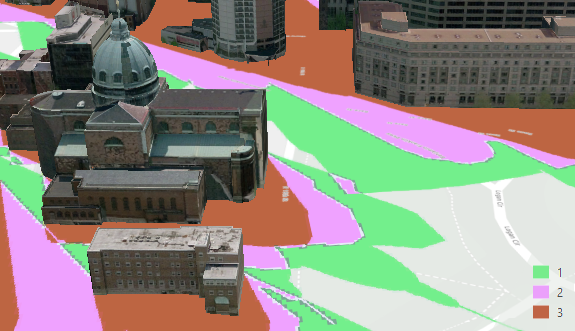| Label | Explanation | Data Type |
Input Features
| The multipatch features that will constitute the source of obstruction for sunlight. | Feature Layer |
Ground Surface
| The raster ground surface that will define the positions where sunlight obstruction will be evaluated. | Raster Layer |
Output Shadow Raster
| The output raster whose cell values reflect the number of times the corresponding ground height position was obstructed by the input features. | Raster Dataset |
Output Cell Size (Optional) | The cell size of the output raster. | Linear Unit |
Start Time
(Optional) | The date and time sun position calculations will begin. The default value is the date and time the tool is initialized. | Date |
End Time
(Optional) | The date and time sun position calculations will end. The Time Interval parameter is used to iteratively evaluate each day from the start time to the end time. For this reason, the end time cannot be earlier than the start time. | Date |
Time Interval
(Optional) | The interval that will be used to calculate sun positions from the start date and time to the end date and time. | Time Unit |
Time Zone
(Optional) | Specifies the time zone that corresponds to the specified input times that will be used to determine the relative position of the sun.
| String |
Adjusted for Daylight Saving Time
(Optional) | Specifies whether the input times will be adjusted for daylight saving time.
| Boolean |
Maximum Shadow Length
(Optional) | The maximum distance that a shadow will be cast from an input feature during calculation. Consider defining this value when the sun position has a low altitude angle, as the resulting shadows will be long and potentially add unnecessary processing time. | Linear Unit |
Summary
Calculates the number of times a fixed position on a surface has its direct sight line to the sun obstructed by multipatch features.
Illustration

Usage
The sun position will be calculated from the start date and time to the end date and time. If a time interval is specified, the sun position will be iteratively calculated from the start time to the end time for each day between the start date and end date. Any time the sun is not above the horizon will be skipped.
The output raster's cell values represent the number of times a given cell is in a shadow. The maximum possible value for any cell corresponds to the number of times the sun is positioned above the horizon.
Consider defining a maximum shadow length when generating results for sun inclination angles near sunrise and sunset to avoid factoring the impact of long shadow footprints. Enforcing a distance also helps improve tool performance.
Parameters
arcpy.ddd.SunShadowFrequency(in_features, ground, out_raster, {cell_size}, {start_time}, {end_time}, {time_interval}, {time_zone}, {dst}, {max_shadow_length})| Name | Explanation | Data Type |
in_features [in_features,...] | The multipatch features that will constitute the source of obstruction for sunlight. | Feature Layer |
ground | The raster ground surface that will define the positions where sunlight obstruction will be evaluated. | Raster Layer |
out_raster | The output raster whose cell values reflect the number of times the corresponding ground height position was obstructed by the input features. | Raster Dataset |
cell_size (Optional) | The cell size of the output raster. | Linear Unit |
start_time (Optional) | The date and time sun position calculations will begin. The default value is the date and time the tool is initialized. | Date |
end_time (Optional) | The date and time sun position calculations will end. The time_interval parameter is used to iteratively evaluate each day from the start time to the end time. For this reason, the end time cannot be earlier than the start time. | Date |
time_interval (Optional) | The interval that will be used to calculate sun positions from the start date and time to the end date and time. | Time Unit |
time_zone (Optional) | Specifies the time zone that corresponds to the specified input times that will be used to determine the relative position of the sun.
| String |
dst (Optional) | Specifies whether the input times will be adjusted for daylight saving time.
| Boolean |
max_shadow_length (Optional) | The maximum distance that a shadow will be cast from an input feature during calculation. Consider defining this value when the sun position has a low altitude angle, as the resulting shadows will be long and potentially add unnecessary processing time. | Linear Unit |
Code sample
The following sample demonstrates the use of this function in the Python window.
import arcpy
arcpy.env.workspace = 'd:\\data'
arcpy.ddd.SunShadowFrequency('Buildings.shp', 'DEM.tif', 'June_Shade.tif',
'4 Feet', '6/1/2018 10:00 AM', '6/30/2018 4:00 PM',
'15 Minutes', 'Pacific Standard Time', 'NO_DST')